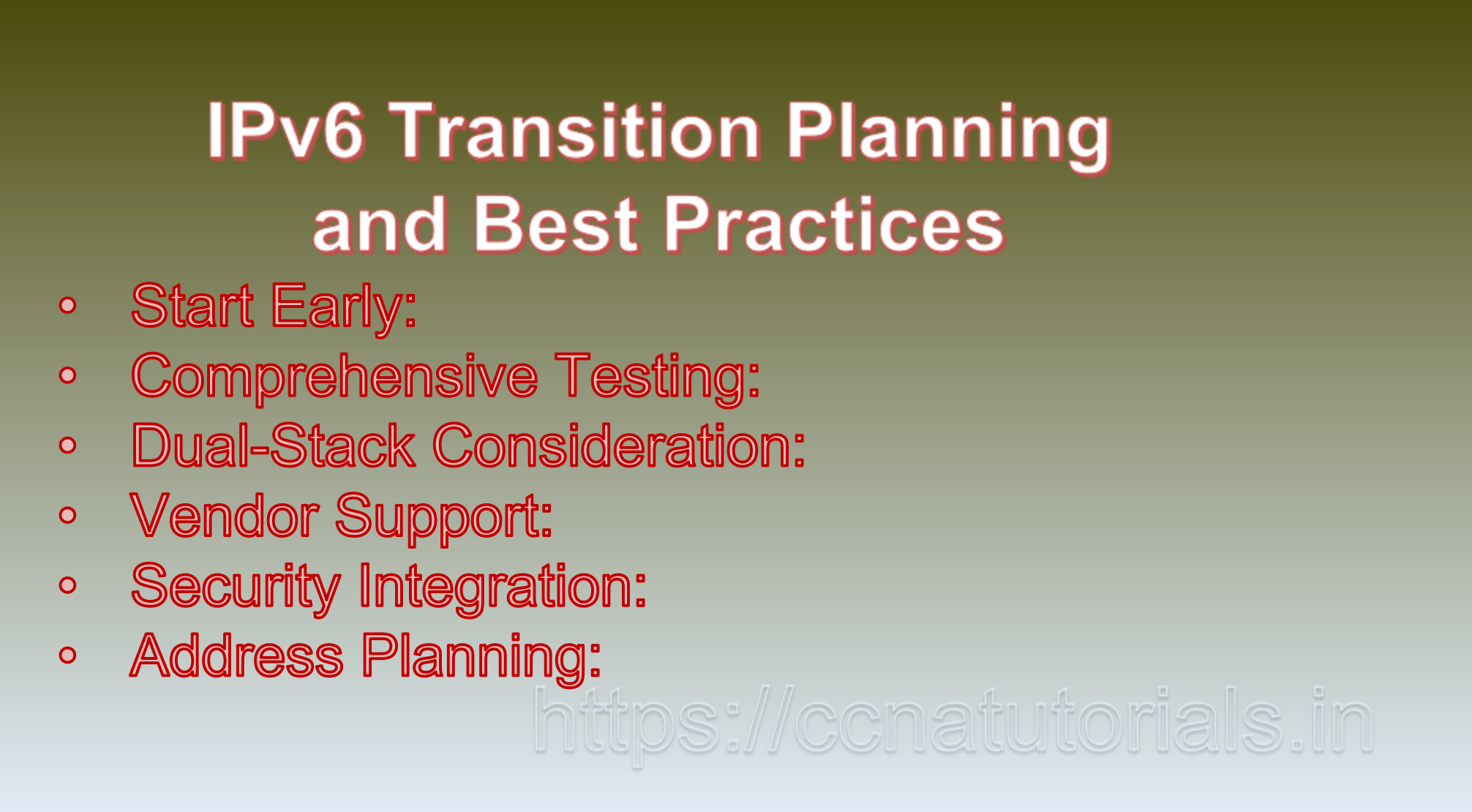Contents of this article
In this article, I describe IPv6 Transition Planning and Best Practices: Ensuring a Smooth Migration. IPv6 transition planning is a critical process for organizations looking to migrate from the current IPv4 protocol to the newer IPv6 protocol. Proper planning helps ensure a seamless transition, minimal disruption to services, and the efficient utilization of network resources. This article presents an overview of IPv6 transition planning and outlines best practices to guide organizations through this complex process.
IPv6 Transition Planning:
1. Assessment and Inventory:
– Begin by assessing your organization’s current network infrastructure, including devices, applications, and services that rely on IPv4.
– Create an inventory of all network components, noting which are IPv6-compatible and which require updates.
2. Define Objectives:
– Clearly define the objectives of the IPv6 transition, such as improved address space, enhanced security, and support for new technologies.
– Determine whether your organization will adopt a dual-stack approach, tunneling mechanisms, or other strategies.
3. Resource Allocation:
– Allocate necessary resources, including budget, personnel, and time, to ensure a successful transition.
– Identify potential challenges and allocate resources to address them effectively.
4. Education and Training:
– Provide training to network administrators, engineers, and other relevant staff members on IPv6 concepts, deployment strategies, and best practices.
5. Pilot Testing:
– Begin with a pilot IPv6 deployment in a controlled environment. Test the deployment with non-critical services to identify any issues or compatibility concerns.
6. Gradual Rollout:
– After successful pilot testing, gradually roll out IPv6 to other parts of the network, focusing on critical services and devices.
7. Monitoring and Optimization:
– Continuously monitor the network for performance, security, and compatibility issues.
– Optimize the network configuration based on monitoring data and user feedback.
IPv6 Transition Planning and Best Practices:
1. Start Early:
– Begin the transition process as early as possible to ensure sufficient time for planning, testing, and implementation.
2. Comprehensive Testing:
– Test IPv6 compatibility for hardware, software, applications, and services. Identify and address any issues before full deployment.
3. Dual-Stack Consideration:
– Consider implementing a dual-stack environment, where both IPv4 and IPv6 are supported, to ensure compatibility with legacy and modern devices.
4. Vendor Support:
– Choose network equipment, software, and applications that have solid IPv6 support from vendors.
5. Security Integration:
– Integrate IPv6 security mechanisms into the transition plan, including firewalls, intrusion detection, and encryption.
6. Address Planning:
– Develop an IPv6 addressing plan that aligns with your organization’s network architecture and ensures efficient allocation of address space.
7. Backup and Rollback Plans:
– Create backup plans and procedures to handle unexpected issues during the transition process. Ensure that you can roll back to the previous state if necessary.
8. External Connectivity:
– Collaborate with ISPs, cloud providers, and other external partners to ensure proper IPv6 connectivity and compatibility.
Example Scenario:
A medium-sized enterprise decides to transition to IPv6 due to the exhaustion of IPv4 addresses and the need to support growing IoT devices. The organization follows best practices during the transition:
1. Assessment and Inventory:
The organization conducts a thorough assessment of its network infrastructure and creates an inventory of devices and services that need IPv6 support.
2. Pilot Testing:
The IT team sets up a pilot IPv6 deployment in a test environment. They test various services, including email and web hosting, to ensure compatibility and functionality.
3. Gradual Rollout:
After successful pilot testing, the organization gradually enables IPv6 on its internal network, starting with non-critical devices and services.
4. Monitoring and Optimization:
The IT team continuously monitors network performance and addresses any issues that arise during the transition. They optimize the network configuration based on monitoring data.
5. Education and Training:
The organization provides training sessions for network administrators and staff members to ensure a smooth transition and efficient management of the new IPv6 network.
In short IPv6 Transition Planning and Best Practices
IPv6 transition planning is essential for organizations aiming to embrace the advantages of the IPv6 protocol while maintaining seamless services. By following best practices such as starting early, conducting comprehensive testing, considering dual-stack environments, and addressing security concerns, organizations can navigate the transition process successfully. The example scenario illustrates how an enterprise implements IPv6 transition planning, showcasing the importance of careful assessment, pilot testing, gradual rollout, monitoring, and staff education. Through meticulous planning and adherence to best practices, organizations can achieve a smooth, efficient, and secure transition to IPv6, ensuring their networks are well-prepared for the future of networking and connectivity.

IPv6 Transition Planning and Best Practices used for Navigating the Evolution. IPv6 transition planning is a critical process for organizations aiming to adopt the IPv6 protocol and ensure seamless communication in the modern digital landscape. As IPv4 address exhaustion continues and the demand for Internet-connected devices grows, transitioning to IPv6 becomes a strategic imperative. This article provides an overview of IPv6 transition planning and outlines key best practices to guide organizations through this evolution.
IPv6 Transition Planning:
1. Assessment and Inventory:
– Begin by assessing your organization’s current network infrastructure, devices, and services to identify IPv4-dependent components.
– Create an inventory of all networked devices, applications, and services, including their IPv4 dependencies.
2. Define Goals and Objectives:
– Clearly outline the goals and objectives of the IPv6 transition, such as achieving full IPv6 readiness, ensuring service continuity, and maintaining security.
3. Establish a Transition Team:
– Form a cross-functional transition team that includes network engineers, system administrators, security experts, and management representatives.
– Define roles, responsibilities, and decision-making processes within the team.
4. IPv6 Addressing Plan:
– Develop an IPv6 addressing plan that aligns with your organization’s network topology and requirements.
– Assign IPv6 addresses to network segments, devices, and services based on best practices and hierarchical addressing schemes.
5. Vendor and Application Compatibility:
– Verify that your network equipment, software, and applications support IPv6.
– Engage with vendors to ensure compatibility and obtain necessary updates or patches if required.
6. Testing and Pilot Deployment:
– Set up a test environment to evaluate IPv6 functionality, compatibility, and performance.
– Conduct a pilot deployment with a subset of devices and services to identify potential issues and refine your transition strategy.
7. Training and Education:
– Train your IT staff on IPv6 concepts, deployment techniques, and troubleshooting procedures.
– Educate end-users about IPv6 and potential changes in network behavior.
8. Risk Management and Contingency Plans:
– Identify potential risks and challenges associated with the transition.
– Develop contingency plans to address unforeseen issues and ensure minimal disruption to critical services.
IPv6 Transition Best Practices:
1. Start Early and Plan Ahead:
– Begin your IPv6 transition planning well in advance to allow for thorough testing, evaluation, and troubleshooting.
– Establish a timeline that includes milestones, deadlines, and regular progress assessments.
2. Prioritize Critical Services:
– Identify and prioritize critical network services that need IPv6 support. Ensure that mission-critical applications and services are thoroughly tested for IPv6 compatibility.
3. Dual-Stack Implementation:
– Implement dual-stack networking to support both IPv4 and IPv6 concurrently. This approach allows a gradual transition while maintaining compatibility.
4. Monitor and Update Network Equipment:
– Regularly update firmware and software on network devices to ensure they are compatible with IPv6 and to address any security vulnerabilities.
5. Security Considerations:
– Apply security best practices to IPv6 configurations, including firewalls, intrusion detection systems, and monitoring tools.
– Ensure that security policies are adapted to address the unique characteristics of IPv6.
6. Addressing and Subnetting:
– Adhere to IPv6 addressing best practices, such as hierarchical addressing and efficient subnetting.
– Plan for growth by allocating sufficient address space for future devices and services.
7. Test Thoroughly:
– Conduct comprehensive testing in a controlled environment before deploying IPv6 changes to production networks.
– Test different scenarios, including dual-stack communication, network mobility, and IPv6-only environments.
8. Collaborate with ISPs and Peers:
– Coordinate with Internet Service Providers (ISPs) and peers to ensure smooth communication between IPv4 and IPv6 networks.
– Enable Border Gateway Protocol (BGP) peering for IPv6 routes to improve connectivity.
Conclusion for IPv6 Transition Planning and Best Practices:
IPv6 transition planning requires careful assessment, meticulous preparation, and the implementation of best practices to ensure a successful and smooth migration. As organizations navigate the evolution from IPv4 to IPv6, understanding the importance of addressing planning, testing, security considerations, and collaboration with ISPs is crucial. By adopting the best practices outlined in this article and leveraging a well-defined transition strategy, organizations can embrace the capabilities of IPv6 while maintaining compatibility with existing IPv4 infrastructure. As the digital landscape continues to evolve, a well-executed IPv6 transition is essential for future-proofing network infrastructure and enabling seamless communication for users and devices across the globe. You may contact us or drop a comment below for any query related to this article.






